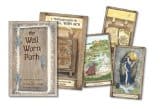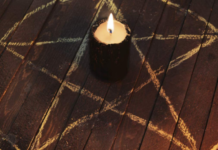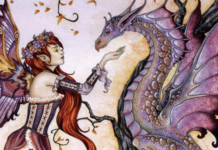
The Well Worn Path
, by Raven Grimassi and Stephanie Taylor, illustrated by Mickie Mueller
Kit: Llewellyn Worldwide, 073870671X, 216 pp., 40 cards, 2005
The kit includes forty beautifully illustrated cards, a black organdy bag, a white cardboard box for sturdier storage, and the companion booklet, A Traveller’s Guide to the Well Worn Path.
Grimassi and Taylor write that the title of the deck was chosen to reflect the idea of ‘…a path trodden by the footsteps of those who have walked in these ways since perhaps the beginning of time. Here our ancestors left to us a trail to the ways we now seek to follow as we extend the path to our new vistas’.1
I was surprised by some of the cards included in the deck, and their descriptions. For example, the ‘Words of the Magus’ (To Know, To Will, To Dare, and To Keep Silence, or, as it is in these cards ‘To Know, To Dare, To Will, To Keep Silent’ – daring before will is known sounds dangerous to me, but perhaps the authors have something else in mind) I have known previously as the Four Powers of the Sphinx in the western mystery traditions. ‘As Above, So Below’ is also a Hermetic maximum, from the compiled writings of Hermes Trismigustus, but here it is not cited thus. These idiosyncrasies among the first few cards did not bode well for the rest of the deck.
There are some nice touches on the cards themselves, such as the inclusion of certain plants on the books within, and decorations on the locks of the trunk which hold special meaning which are explained in the book. However, I get the feeling that more work was put into creating the cards than writing the book that accompanies it.
Grimassi and Taylor believe ‘The central value of this deck is that it presents a series of teachings that can help you understand why the concepts presented are important. It brings you into an experience of each theme and concept instead of simply providing information or inspiring ideas. Because of this the deck is a valuable tool for solitary practitioners who may not be able to find a physical teacher and initiator’.2 Unfortunately, there is not a single citation in the entire book, every ‘ancient tradition’ is left vague, exactly which traditional ‘ancestral spirits’ the authors are speaking of is not clear (my personal ancestors, or specific pre-Christian European spiritual ancestors, or the more general ancestors of all humankind?), nor is there any suggested reading for further study. As a teaching tool it leaves much to be desired.
They write, ‘This deck has been designed to serve four different purposes. It is a deck of divination, a system of teaching, a tool for spiritual alignments, and a means of performing solitary rituals’ (pg 9) and as such each card is accompanied by three interpretations Meaning, Teaching and Alignment. Meaning gives the divinatory meaning for the spreads given in the book, Teaching explains the symbolism in clear, simple terms (as the authors state, the cards could also be used as flash cards to teach new students to immediately recognize the obvious meanings of the cards – though I’m unclear as to why that would be beneficial, meditation on the deeper meanings would seem to be more useful in the long run, rather reciting ingrained symbolic descriptions), and Alignment relays a heavily scripted guided meditation that follows through the forty cards.
They state that ‘The Well Worn Path deck is designed to present and reveal the symbolism, meaning, and teachings that are the far-reaching roots of modern Paganism and the Craft. The images in this deck depict the spiritual and religious concepts that were the foundations of European Paganism as once known to our ancestors…Here we have captured the knowledge and wisdom of ancient times for contemporary application’.3 Exactly what this means is never made clear.
The authors obviously intend something very specific with the cards, and yet write in such a vague manner leaving it open to interpretation and opposition at the worst of times, which seems to negate the point. They state that ‘One of the many unique features of this deck is that you can customize the meaning of these cards to better reflect your own individual symbolism’.4 However, more focus would have been appreciated, as it is, the text comes off wishy-washy rather than practically applicable.
The accompanying book constantly makes reference to ancient ways and ancestral traditions, but there are no specific evidences of that within the deck. The deck presents the same sort of vague neo-pagan mythologies and traditions that we’ve come to expect from Wiccan-based books. This wouldn’t be an issue if the deck was presented as a model for modern Wiccan and neo-pagan traditions; however, with these ‘ancient’ references and a lack of citation as to where these ancient elements are supposed to come into play, it instead leaves me shaking my head.
A tradition doesn’t have to be ancient to be worthwhile. That Wicca is still a newly emerging religion, barely fifty years old, does not make it any more or less legitimate than if it really had been a continuing tradition dating back from Neolithic times. Yes, the roots of pantheism hearken back quite a while, but to associate this, even in a loose way, with what Wiccans or neo-pagans practice today doesn’t make a lot of sense in today’s technologically advanced age. The fact of the matter is the symbolism is not the same, was not universal and it is not interpreted exactly as it was then.
I wish more authors would focus on the beauty of Wicca and neo-paganism within themselves rather than presenting them as a modernized version of ancient practices. We call it the ‘Old Religion’, but unless one is a practicing reconstructionalist, this tends not to be the case… and there is nothing wrong with that! There are many approaches to the divine within and without, but pretending something is what it isn’t helps no-one.
There are a few additional cards I would have liked to have seen. For example, the Wheel of the Year is present, but individual Festivals are not; yet with only forty cards in the deck, there is room to add another eight cards, or even a round ten, if you add Esbats and Diana’s Bow.
Yet other cards seem almost superfluous, such as the Voice of the Wind, or Eightfold Path cards. ‘Voice of the Wind’ is not something I have heard related specifically with Paganism before – it sounds more shamanistic to me than anything else. The only Eightfold Path I have head of previously was the Eightfold Path of Yoga, or the eight kinds of magick in Peter Carroll’s chaos magick. Perhaps these cards are intended to be tradition-specific, but if so, they should be identified as such.
Another criticism I have is that there are no ‘negative’ cards. There is no death, only the Summerland and Reincarnation, and Hecate, a Goddess of Crossroads, is mentioned only in Her lighter aspect and any hints of Her darkness have been dispelled. This leaves the deck feeling unbalanced, and therefore, in my mind, not suitable for divination, as a few test readings further indicated. The Pentagram spread in particular does not feel intuitive, as it does not follow the traditional invoking or banishing forms of any of the readings, it hops around form point to point to centre, not conforming to the fluid pattern of the symbol.
The book concludes with a chapter titled ‘Solitary Rites’ which includes two rituals which make use of the cards in the deck, and advise that other rituals may be created once the basic formula is known. The first, ‘The Rite of the Inward Journey’ is a dedication ritual designed to dedicate oneself to the ‘well worn path’, though there is no specific mention of the Goddess or God in the dedication. The second, ‘Solitary Full Moon Rite’, is a simple ritual involving heavy use of the imagination rather than working with a specific energy or goal. Following that is another guided meditation, with simple instructions on how to create one’s own.
I like the idea behind the cards – a specifically Pagan deck intended to provide guidance and teachings, and the deck itself is rather pretty, but I can’t recommend the kit as it is. The booklet leaves much to be desired in its presentation and practicality; there are too many gaps. I believe it is possible to purchase the deck independently, and new Pagans may be interested in doing so, but I can’t see any value in it for the experienced or as a teaching tool.








